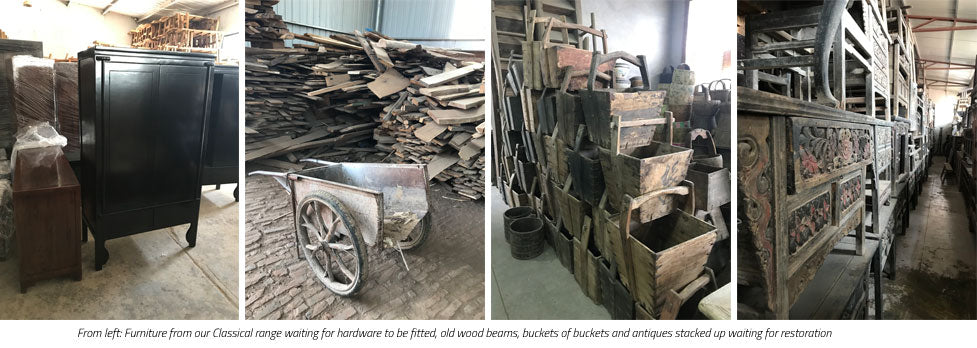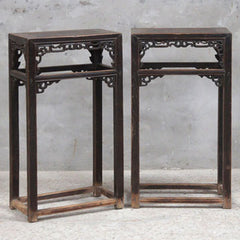
Fabulous new finds in China
I'm just back from a very productive trip to China, where I was checking on our next consignment of reproduction furniture - black lacquer and solid elm pieces from our Classical Chinese range, as well as scouring our various suppliers' warehouses to select antique furniture to ship over to the UK in the coming months. Over the next few weeks we'll be sharing photos of some of my favourite pieces on Facebook and Instagram, and you'll be able to view the antiques I selected on our website soon. In the meantime I've picked out just one or two highlights below - really special or unusual pieces that I can't wait to get hold of here in our showroom.
After a quick stop off in Hong Kong to catch up with old friends and one of our long-term industry partners who moved there recently, I headed up to Beijing - my base for the next week, from where I travelled further afield to visit our various suppliers. I've mentioned in previous posts that just about all the smaller antique restorers and furniture producers have been forced out of the Chinese capital over recent years as the local government looks to tackle the pollution issue within the city and, perhaps more importantly to them, redevelop land occupied by smaller enterprises. As a result many factories have closed down, and those that have survived have had to move further afield - to Tianjin, Hebei, Shandong or even further out. For me this means more time spent travelling around and a stop over in Shandong province. It makes a trip slightly more time consuming but does mean that I get to see a little more of the country.
 My first point of call was the workshop that we work with to produce our Chinese Classical furniture. I'd timed my visit to check on furniture that's due to be finished and loaded on a container in the next couple of weeks, arriving with us around mid August. Like many others, this particular supplier moved out of Beijing a couple of years ago, taking with them not only their carpentry team, woodworking equipment and supply of old elm and poplar wood, but also a large stock of antique Chinese furniture that they have had in storage for many years, waiting to be repaired. They have some unusual pieces that I've rarely seen elswhere, and it was great to be able to search through some of their stock and pick out one or two gems. They will be restoring these for us over the next few weeks so that we can include them with a future shipment so more details to follow.
My first point of call was the workshop that we work with to produce our Chinese Classical furniture. I'd timed my visit to check on furniture that's due to be finished and loaded on a container in the next couple of weeks, arriving with us around mid August. Like many others, this particular supplier moved out of Beijing a couple of years ago, taking with them not only their carpentry team, woodworking equipment and supply of old elm and poplar wood, but also a large stock of antique Chinese furniture that they have had in storage for many years, waiting to be repaired. They have some unusual pieces that I've rarely seen elswhere, and it was great to be able to search through some of their stock and pick out one or two gems. They will be restoring these for us over the next few weeks so that we can include them with a future shipment so more details to follow.

The sideboard above is one of the stand-out pieces from my trip to our suppliers in Shandong. It comes from Shanxi province and dates from the beginning of the 20th century, with the original red lacquer and detailed paintings on the doors all still in place. I love the carved spandrels at either side - stylised dragons that scroll up to the top, as well as the very rich, deep red colour. The decorative paintings, once in bright gold, have now faded to the base black outline below. However the detailed figures, buildings and distant landscape can all still be clearly made out.
 After two days in Shandong I took the train back to Beijing, visiting one of the few antique furniture showrooms left in the capital the next day, before a day trip to nearby Tianjin to see two more of our our regular antique suppliers. These two are amongst some of the longest established antique specialists around and both continue to have an excellent selection, particularly of furniture from Shanxi province. Amongst other things I was on the hunt for tea tables or vase stands for a couple of different customers and there was plenty of choice. My favourite were the pair shown here - elegantly proportioned and again with open carvings on the apron and beneath the stretchers to represent dragons. The very stylised design was a way to show this highly powerful symbol without falling foul of the rule that only the Chinese emperor was allowed to show 'real' dragons. This pair dates from around 1850, again from Shanxi province and in elm, still with the original, though now worn, dark finish.
After two days in Shandong I took the train back to Beijing, visiting one of the few antique furniture showrooms left in the capital the next day, before a day trip to nearby Tianjin to see two more of our our regular antique suppliers. These two are amongst some of the longest established antique specialists around and both continue to have an excellent selection, particularly of furniture from Shanxi province. Amongst other things I was on the hunt for tea tables or vase stands for a couple of different customers and there was plenty of choice. My favourite were the pair shown here - elegantly proportioned and again with open carvings on the apron and beneath the stretchers to represent dragons. The very stylised design was a way to show this highly powerful symbol without falling foul of the rule that only the Chinese emperor was allowed to show 'real' dragons. This pair dates from around 1850, again from Shanxi province and in elm, still with the original, though now worn, dark finish.
Lastly, the unsual low sideboard below is in the distinctive, almost Moorish style of furniture from Xinjiang province in the far northwest of China. With a large Muslim population and bordering Pakistan, Kazakhstan and other central Asian countries, the region has its own unique identity which is reflected in the furniture produced there for centuries. Produced as a large daybed, this unit has been reduced in depth and doors added to the front to produce a more practical sideboard that would also be ideal as a large TV stand. The geometric carvings and pastel colours are all original - the blues, pinks and yellows faded from the original brighter shades.

You'll find more photos from my trip on our Facebook and Instagram pages, and look out for the antiques mentioned here and dozens of others I selected over the coming weeks as we add these to our website. Keep an eye on our 'new arrivals' if you want to be the first to see these, or get in touch if you are looking for a particular piece.
James Cottrell
Director, Shimu
Main image (top) - detail from 19th century Shanxi red lacquer wedding cabinet with gold decoration.





Leave a comment